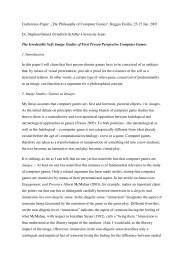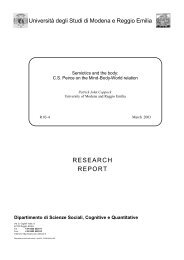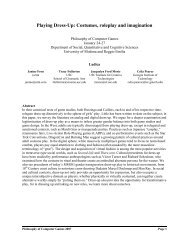+++ INCOMPLETE DRAFT VERSION (PLEASE DO NOT QUOTE) ++ ...
+++ INCOMPLETE DRAFT VERSION (PLEASE DO NOT QUOTE) ++ ...
+++ INCOMPLETE DRAFT VERSION (PLEASE DO NOT QUOTE) ++ ...
Create successful ePaper yourself
Turn your PDF publications into a flip-book with our unique Google optimized e-Paper software.
environment through skillful use of the tools and strategies offered by thegameplayenginethatcreatesandmaintainstheinteractivefictionalworld.Other, ever more sophisticated online multiplayer simulation and gameenvironments offer opportunities for player initiative and co‐constructionactivities, not only by way of finding personalised interpretational narrativepathways through the fictional environment, but also through redesigning,complementingandreformingitinvariousways.Thisalters,sometimesinquiteradicalways,thegeneralandmorespecificcontextsinwhichdifferentkindsofplayer‐gameplayandplayer‐playerinteractionoccur.This is clearly be a very different kind of media experience from that ofconsumersoftraditionalcinematicfiction,althoughcinema‐goers(asisthecase,as Iser, Eco and others have pointed out, also for consumers of “paper‐based”literature) certainly play an active co‐constructive role in interpreting, andattributing sense to, the narrative program of a film as it unfolds before theireyes.Inthecaseofcinematicfictionalnarratives,however,suchinterpretationprocesses largely take place without any significant degree of whole body, orevenbodypart,movementonthepartofviewers,andtodayitisofconsiderableinteresttospeculateabout,anddiscuss,justwhatthisquitespecificdifferenceintermsofwhatweshallrefertohereasembodiedimmersionprocessesmayhavetosayinexperientialandculturalvaluetermsforconsumersofoneortheothertypeofmediaartefact,andinthelongerterm,forthedifferentculturalcontextsand(notleast)marketplacestheseartefactsatpresent‘populate’.






